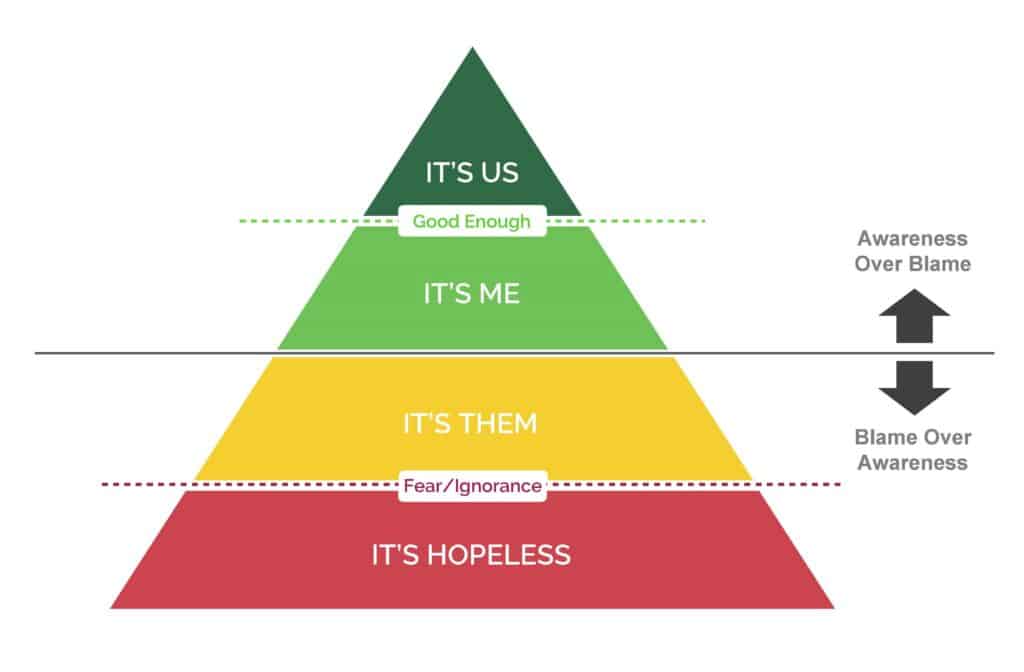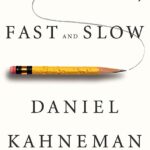As a coach and a former HR leader here’s a truth that I’m quite clear on, folks in the world of human capital LOVE a psychometric assessment. We assume everyone will “get it,” find it fascinating and see how to apply the insight gleaned from the assessment.
But here’s the real head-scratcher that we regularly encounter, leaders who have awareness but struggle with bridging that awareness into action. It’s fascinating because it typically happens in the organizations that have all the systems and structures in place. The talent assessments are strong, leaders have good self-insight and maybe even are regularly able to tap into coaches and yet still that leap into the next step of collective leadership, shared accountability and moving beyond is elusive.
This light green part of our organizational pyramid is what we call the “It’s Me” level. These are the organizations that have hopped over what we call the “blame line” and into awareness. The leaders have been doing the “inside out” work and understand themselves better. The teams are aware of personal impact but blind to how to fully leverage others and remain reliant on pockets of greatness to drive results. It’s an organization where the possibilities are clear, the potential has been identified but consistently leaders within the system buy into the myth of “heroic leadership” — that they alone are solely responsible.
The “Good Enough” Organization
In these types of “Good Enough” organizations, you often see:
- Leaders who are so self-aware they risk being self-indulgent. Claiming a need to be their authentic self and risking being myopic to the broader needs within the team.
- Heroic teams that are highly individualistic. Still the sum of the parts rather than tapping into a collective strength.
- Cultures where it’s clear that the work to create shared ownership is happening but it’s not consistent yet.
In this context then assessments can often become an “oh yeah, that’s me” type of reminder and then promptly filed away, never again to be accessed by the working memory of the recipient. Sadly, destined to be about as insightful as a BuzzFeed quiz telling you which Hogwarts school you’d likely be sorted into, or with which breed of dog you most identify.
These assessments sit in the zone of being “good enough.”
You know that zone. You can tick the box that says, “This leader has completed leadership assessment for self and team” and comfortably say, “yes” we have completed the assessments.
But is “good enough” really where we want to stop?
We’d suggest it’s not enough to just know. We want to integrate these juicy insights into our reality to make things better. One thing we’ve learned in our work with our clients is that the very best organizations, who get to the top of the pyramid, simply don’t buy into that myth. They recognize the truth that no one can’t do it alone. To achieve our goals, we must work as a collective.
A Shift to The Collective
Here are a few tips to consider if you’d like to understand what more is possible:
- Shock the System
Have you got a leader who’s been assessed (perhaps a lot) but nothing has changed? Look at the quality of the assessments.
- Do they help a leader get crystal clear on the ONE behaviour that they need to amplify to be more effective?
- Or does the assessment provide a bunch of helpful tips on how to best work with other “types”?
If it’s the latter, then you’ve been muddying the water. No wonder the leader hasn’t shifted their leadership style. It might be necessary to shock the system with a Class A psychometric that clarifies the big bang for the buck behaviour, so to speak, and then is integrated into a longer-term program to support the leader in their development journey.
- Think Integration
Assessments can be fantastic to help create empathetic bonds between members of teams and build insight but one and done is never the way to go. Before utilizing any assessment, consider about the natural points of integration within the team so that it becomes part of the way the team works. For example,
- Look at your cadence, agendas and content of standing meetings.
- Consider how your team provides appreciation and recognition.
- Identify the established learning experiences that the team engages in regularly.
How can the language of the assessment weave itself into the current ways of working so that it remains useful and top of mind for the team members?
If you’re interested in learning about how we leverage assessments to gain insight, cultivate leadership cultures, build teams where strengths are leveraged and realize collective impact, book a scoping call with a member of our team. We’d be happy to discuss what the right next step forward is to build a sustainable culture of engagement, performance and results.




